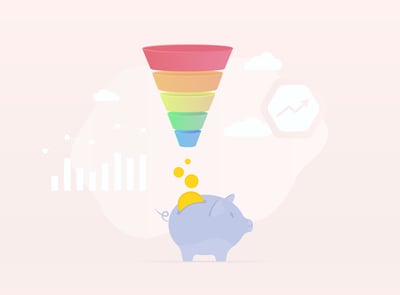July 1, 2021
 by Praveen Swaminathan / July 1, 2021
by Praveen Swaminathan / July 1, 2021

Successful sales efforts are seldom random, and organizations leave nothing to chance.
To drive consistent sales growth, they follow a set, repeatable pattern in their sales work. It includes mapping the buyer journey, buyer personas, sales cycles, referral programs, and more. Generally, organizations that see long-term growth guide their sales reps through every step of their sales journey.
A sales cycle is a series of events or steps that salespeople follow when making a sale. It varies from one organization to another based on whether they sell directly to customers or businesses, the complexity of the product, the geographic location, and so on.
A well-defined sales cycle helps you with the following advantages:
When creating a sales cycle, you need to factor in:
Selling a B2B product requires relatively more decision-makers, high-value deals, and a longer sales cycle. Whereas for consumer goods, the sales cycle tends to be shorter because of the (usually) lower deal value and the smaller number of decision-makers involved. In either case, while most sales cycles have a set of common logical steps, they need to be customized according to the product and the type of buyer.
Now that you know what a sales cycle is and why it is necessary, let’s look at the different stages of a sales cycle.
The first stage in a sales cycle is prospecting for customers, i.e., identifying potential customers. First, you need to define your ideal buyer persona by answering the following two questions:
As you continue to think and find answers to these questions, you get a clear idea of your product’s unique selling point and key value proposition. Once you identify your USP and KVP, you can easily define your ideal customer profile or buyer persona.
Buyer personas must include the following attributes:
After creating your ideal buyer persona, generate a database of potential leads who match that profile. This can be done via lead databases such as Zoominfo, Crunchbase, or popular social media platforms like LinkedIn.
For B2B, you also need to identify the individual prospects that you can contact – decision-makers or those who have the power to influence the purchasing decisions.
In the second stage, prepare and research your prospects. If you’re a B2B vendor, you need to know a prospect’s company history, business type, top customers, key competitors, industry insights, recent achievements, and so on.
You can get this information from their company website, press releases, social media handles, websites like G2, and many other similar platforms. If you sell directly to a customer, research their key demographics, needs, concerns, and limitations.
Once you’re prepared, you also need to identify the best ways to contact your ideal buyer persona. It could be through emails, cold calls, social media, or a combination of different communication channels and methods.
In the third stage, you contact the prospects for the first time. The first call is a do-or-die moment for most businesses. You get one shot at creating a great first impression. Use this call to understand your prospects and their needs.
Ask open-ended questions. While setting any sales target for the current financial year, ask your prospects how they plan to achieve these targets; determine their approach. Asking open-ended questions allows customers to talk, helping you to build a good rapport at the same time.
Do not pitch your product just yet. First, provide an overview of your product and qualify the prospects to see if they’re fit to move forward in the sales funnel. You can use BANT, a popular framework, to qualify prospects.
Sales teams consider a prospect qualified if they meet two, three, or all of the BANT criteria. This varies depending on the type of products and the business.
The initial sales call aims not to sell but to know more about the prospects, their motivations, and key pain points. You should use the introductory pitch to make a positive impression and earn your prospect’s trust.
Presenting your product or service is the most important stage in a sales cycle. You have identified, contacted, and qualified the prospects. Now you pitch your product. Sales reps often only talk about a product’s features, which isn’t enough. To improve conversions, your pitch should include the following aspects.
While qualifying the prospects, you also learn more about their needs. Therefore, explain the product features that are relevant to a prospect’s needs. If you’re selling a CRM solution to a sales manager, explain how it provides a 360-degree overview of all buyer interactions rather than how it’s used to automate marketing campaigns. Your pitch should address a prospect's immediate needs.
What is the unique difference between your product and the others on the market? Is it cheaper, easier to use, or has additional features? Emphasize this in your pitch. Identifying and presenting your product’s USP will help your product stand out in a prospect’s mind.
Specify the expected business outcomes of using your product. If you’re selling a marketing automation software, clearly explain what marketing goals the prospect can achieve using your product ( improved email campaigns, enhanced social media marketing, etc.). Make sure your prospects know why they’re using your product and what results are expected.
Quantify the outcome in monetary terms - improve revenue by 23%, save $500 per user, and so on. The prospect should see the monetary value of purchasing your product, which enables quick decision-making.
Your sales pitch should be less about what your product has and more about what it does. Sell the shade, not the branch.
Once you make the sales pitch, prospects start voicing their concerns about your product. Although sales reps face sales objections all the time, many fear these objections and view them as potential obstacles, whereas a prospect raising objections is actually a positive indicator. It shows that they’re considering your product but have some issues that need to be ironed out.
So what can you do to handle objections? Use the right tools and techniques to address concerns and resolve them in time.
One of the most widely used and effective techniques to handle sales objections is LAER, which includes:
Actively listen to the prospects. Make sure that you don’t interrupt them while they’re talking. Often, sales reps interrupt the prospects by assuming what the objection is (commonly known as Heuristic bias) and providing ready-made answers. If you have a prepared response, it means that you weren’t listening. You should always listen to understand, which shows that you care about your prospects and are keen to answer their questions.
Acknowledging the objection shows the prospect that you’re actively listening. A simple way to acknowledge is to mirror or repeat the last few words or critical words of the objection.
Suppose a prospect says, “I am not too sure if we can get into a contract with you at the moment,” you can acknowledge with, “I understand you have issues getting into a contract with us in the current situation.”
There are two potential objections here. Acknowledging them will help you identify which is more important for the prospect - getting into a contract with you or getting into a contract under the present circumstances.
Before exploring suitable responses, verify. Prospects may use objections as a smokescreen for something deeper. Often price objections are raised because the prospects don’t see any value in the offering. That’s why you need to probe further to understand the real objections and explore suitable responses.
Once you have a clear understanding of the prospect’s objection, provide a suitable response. Be sure to address every objection. Unaddressed objections can be major deal-killers.
You also need to be prepared and understand the top concerns of your prospects. Typically, sales objections are of the following types:
The key to handling objections is preparation. Make a list of all the objections that you’re likely to encounter with the appropriate responses. Constantly update and share it with the rest of your team.
At this stage of a sales cycle, prospects become paying customers. It is therefore important to close your sale using the right closing techniques. Some of these closing techniques are:
Also, ensure that there’s minimum documentation and a simple billing process to create a smooth buying experience for the prospects.
It’s not the sole responsibility of the customer success or support team to retain the customer. The sales teams also play a major role in this.
You were their first point of contact; they purchased the product from you because they trusted you. It’s now up to you to maintain a good working relationship with the customers - follow them up, check for any issues, and ask for feedback.
If you have any customer marketing initiatives, invite your customers and share relevant materials. Keep them informed of product and feature updates. This will help your customers get the maximum benefit from your product while getting you repeat business and referrals.
Remember, it’s easier and cheaper to retain an existing customer than gain a new one.
Effective sales cycles should factor in the buyer's journey as well. This includes having a thorough understanding of your buyer persona, their requirements, preferred communication channels, and other relevant details.
70% of the buyer’s journey is complete before the first contact with a sales rep. So, for your sales cycle to be effective, sales and marketing should be appropriately aligned to ensure that only suitable prospects are targeted.
The sales cycle is the bedrock of successful sales strategies. A good sales cycle shouldn’t be a stagnant, one-time affair but constantly evolve with the circumstances. Sales teams need to be fully familiar with the sales cycle to navigate the sales storm successfully.
Step up your sales team's progress by visualizing complex information and data using a sales funnel.
Praveen Swaminathan works on the product marketing team at Salesken. Aside from working on creative ways to evangelize AI and conversation intelligence products, he is a history buff obsessed with political events of the 20th century.
Selling SaaS products is no different than selling any other product.
 by Jeremy Moser
by Jeremy Moser
Merely being a blip on your customer’s radar isn’t enough. In today’s crowded market, lead...
 by Yashwathy Marudhachalam
by Yashwathy Marudhachalam
OKRs, a goal-setting and execution framework born in Silicon Valley and championed by...
 by Senthil Rajagopalan
by Senthil Rajagopalan
Selling SaaS products is no different than selling any other product.
 by Jeremy Moser
by Jeremy Moser
Merely being a blip on your customer’s radar isn’t enough. In today’s crowded market, lead...
 by Yashwathy Marudhachalam
by Yashwathy Marudhachalam


